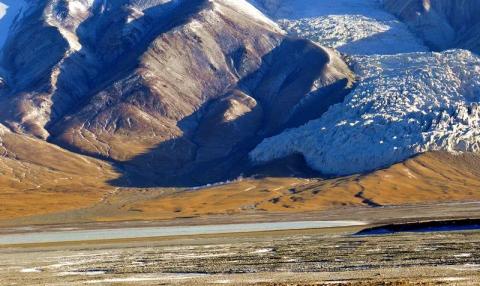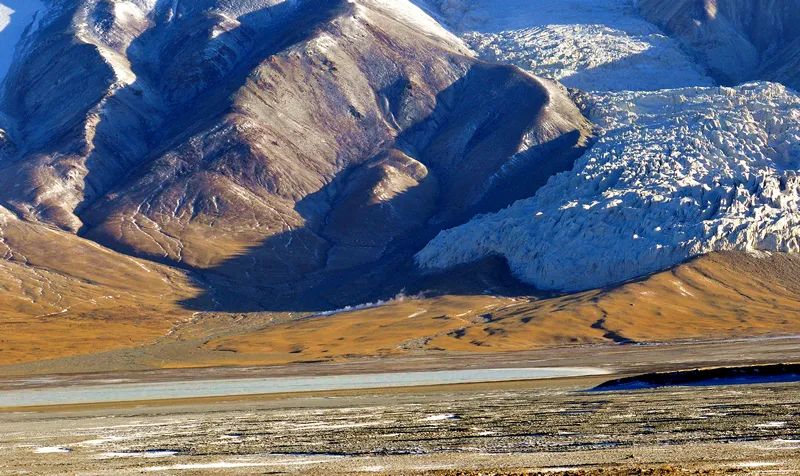Recently, the disappearance of a 24-year-old female college student who entered the no-man’s land of Hoh Xil alone has attracted the attention of many netizens.
Although everyone hoped that she would be safe, unfortunately, her remains were eventually discovered by the police a few days later in an uninhabited area on the south side of Qingshui River in the Hohhot West Nature Reserve.
According to police reports, the location where the girl's accident occurred is already in the core area of Hoh Xil's no-man's land.
Photo | Mill user·WutongshanrenAs soon as the report came out, there were voices of accusation, abuse, regret and regret. Whether we entered accidentally or went there with the intention of committing suicide, we have no way of knowing.The deceased is deceased and any further comments are meaningless. A life was lost, leaving only endless sadness.This incident brought Hekexili to the public’s eyes again.Where is Hoh Xil? What is no man's land?Hoh Xil is a wasteland in China, which becomes beautiful because of its remoteness. Here, the snow-capped mountains stretch out, the roads are aligned with the sky, beautiful lakes, snow-capped mountains and glaciers, and countless rare wild animals.Photo | Mill user·WutongshanrenPeople who have only traveled along the Sichuan-Tibet and Qinghai-Tibet lines may not understand the despair in Hoh Xil. After all, there are too many people and cars on these two lines.The geographical scope of the Hoh Xil region includes the part of northern Tibet known as the "Qiangtang Grassland", the area south of the Kunlun Mountains in Qinghai, and the areas adjacent to Xinjiang, Tibet and Qinghai, with a total area of 250,000 square kilometers.Hoh Xil Nature Reserve has a total area of 4.5 million hectares. It is one of the nature reserves with the largest area, highest altitude and richest wildlife resources built in China.The core area is between the Hoh Xil Mountain and the Ulan-Ula Mountain-Dongbule Mountain, covering an area of 1.55 million hectares.my country generally divides nature reserves into core areas, buffer zones and experimental areas according to their functions.The core area is the concentrated distribution of well-preserved natural ecosystems and rare and endangered animals and plants in the reserve. All interference is strictly prohibited in the core area.A buffer zone of a certain area can be designated on the periphery of the core area, and only scientific research and observation activities are allowed to enter.The experimental area can be used for scientific experiments, teaching internships, visits and inspections, tourism and other activities, and there can also be a small number of residential areas and tourist facilities.Therefore, what currently allows ordinary human activities is the experimental area in the nature reserve. A tourist zone has been established outside the Hoh Xil Nature Reserve, and tourists can choose to drive through Hoh Xil by themselves.How dangerous is this "far away"?Photo | Mill user·Old MondayBecause it is located in an uninhabited area, Hoh Xil has maintained the most natural primitive ecology, and the natural scenery is unique and beautiful. Many people are attracted by its beautiful appearance, ignoring the harsh natural conditions hidden underneath, and boldly go there.Danger is everywhere in Hoh Xil.Let’s first take a look at the wild animals in Hoh Xil: Tibetan antelope, wild yak, Tibetan wild ass, white-lipped deer, snow leopard, which are the first-level protected animals; argali, blue sheep, Tibetan gazelle, brown bear, lynx, and rabbit cat, which are the second-level protected animals. , stone marten, jackal, etc.; there are more than 230 kinds of wild animals living here.Wild animals that have not been domesticated are just like Hoh Xil: they look cute but are actually dangerous.Photo | Mill user·Old Monday circefoxVery aggressive animals such as brown bears, wild yaks, and plateau wolves often appear here. In an area where animals call the shots, the chances of human beings winning are almost zero, and the cruel laws of the jungle can be enforced at any time.Even if you are lucky enough to survive, after being injured at high altitude, the wound will be difficult to heal, and you must race against time for treatment, otherwise the high altitude and low temperature will quickly kill your life.The uninhabited area is large and seemingly endless, but in fact the sandy land is covered with swamps, quicksand, mire and wetlands.The movie "Kekexili" interprets this heart-wrenching scene. The moment he got off the car, mountain ranger Liu Dong stepped on quicksand that was no different from ordinary sand, and slowly began to sink, and finally evaporated.
Gif | Movie "Kekexili"
You never know what you are stepping on, and there is nothing you can do to reverse it.The average altitude of Hoh Xil is over 4,000 meters, and the local air oxygen content is very low. In addition to causing altitude sickness, it can also cause diseases such as pulmonary edema and tracheitis.Photo | Mill user·WutongshanrenIn order to preserve physical strength under the conditions of high cold and hypoxia, we cannot walk or talk loudly here.Hoh Xil No Man's Land is a wilderness area. The climate here is unpredictable. Originally it was clear skies, but in the blink of an eye there would be heavy rain, or even rain and snow. Huge temperature differences alternate with extreme weather.The year-round temperature is -10°C, and the lowest can reach more than minus 40 degrees. There is very little precipitation. Although there are many lakes, they are all saltwater lakes and cannot be drank directly. And most of them are seasonal rivers, often dry.
Photo | Mill User · Northwest Ga Old Man
There are no signals here, no traces of human habitation or roads. Under the conditions of extremely complex landforms, humans cannot survive here.In a primitive ecological area, when encountering danger, you can only find ways to save yourself. Even if you call the emergency number, it is difficult to guarantee that you will be found.Protected areas protect nature and humansChina's four major uninhabited areas: Lop Nur, Altyn Tagh, Hoh Xil, and Qiangtang in Tibet. They are distributed in Qinghai, Tibet and Xinjiang regions of China.Because it is sparsely populated and mysterious, it has become a favorite place for explorers. Traveling through no man’s land is the dream of many travel enthusiasts.Photo | Mill User · Rocky TigerIn the early years, there were some great people on the mill forum who successfully drove themselves through no man's land. There is no denying that they are brave and admirable.The seniors had done enough homework and prepared all the materials, but according to their descriptions, they almost gave up several times and died in no man's land.They are lucky to have come back, but how many lucky people are there?Currently, the four uninhabited areas are included in nature reserves such as Qiangtang, Hoh Xil, and Sanjiangyuan. Since 2017, Hoh Xil has also explicitly prohibited illegal crossing. Those who illegally break into the core area will face high fines and jail time, but legal regulations do not make people "cowardly".Hiking routes with high risk factors such as Aotai are now strictly prohibited, but many people still go there every year. What you can't get is always in commotion, and adventurers eager to try come one after another...The establishment of protected areas protects both nature and humans.Protected areas are reserves of biological species and sanctuaries for saving endangered biological species.Along the railway line from Kunlun Mountain to Tanggula Mountain, you can easily see these elves on the plateau - Tibetan antelopes from the train window during the seasons of June and December every year.Photo | Mill user·WutongshanrenWhen female Tibetan antelopes give birth to offspring, they have to travel thousands of miles to Hoh Xil to give birth. Abundant food and a relatively safe environment are conducive to the production and growth of Tibetan antelopes.As a typical representative of the fauna of the Qinghai-Tibet Plateau, the Tibetan antelope has inestimable scientific value. Thirty years ago, the number of wild animals declined sharply due to the influx of illegal poachers.Countless protectors have lost their lives in confrontations with poachers. Influenced by the heroic sacrifice of Sonam Dajie, the Hoh Xil National Nature Reserve was established.In memory of Suonandajie, the first conservation station in the Hoh Xil Reserve was named after him. (Interested friends can watch the movie "Kekexili" based on Soonandajie )Nowadays, with the continuous improvement of the reserve and the efforts of volunteers, the survival rate of Tibetan antelope lambs has been maintained at about 50%, and the number is slowly increasing.Protected areas were established to protect the natural background. This natural "background" is the path that should be followed when utilizing and transforming nature in the future, providing people with evaluation criteria and the expected consequences of human activities.Therefore, in the final analysis, it is also to protect human beings.Lin Yutang wrote in "The Art of Living": Nature itself is always a sanatorium. Even if it cannot cure other diseases, it can at least cure human hubris .There are always some boundaries in this world that we cannot break or cross. What is lost is not only life, but also things that are irreversible.Poetry and distance are an ideal state of life, not caused by changes in environment and geographical location. Some marketing accounts use the slogan "Poetry and Distance" and sell "niche" and "distance", which changes the flavor of this sentence and makes ignorant people fall into confusion.I believe that most people are sensible: they do not travel for the sake of distance, nor do they take risks for the sake of adventure. 



















